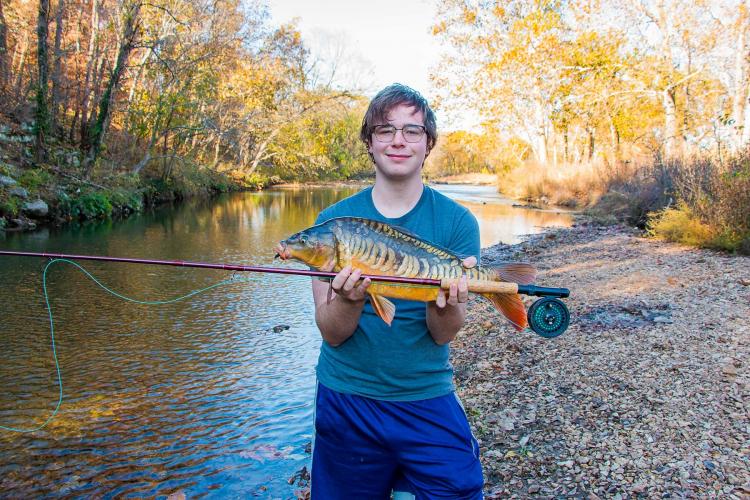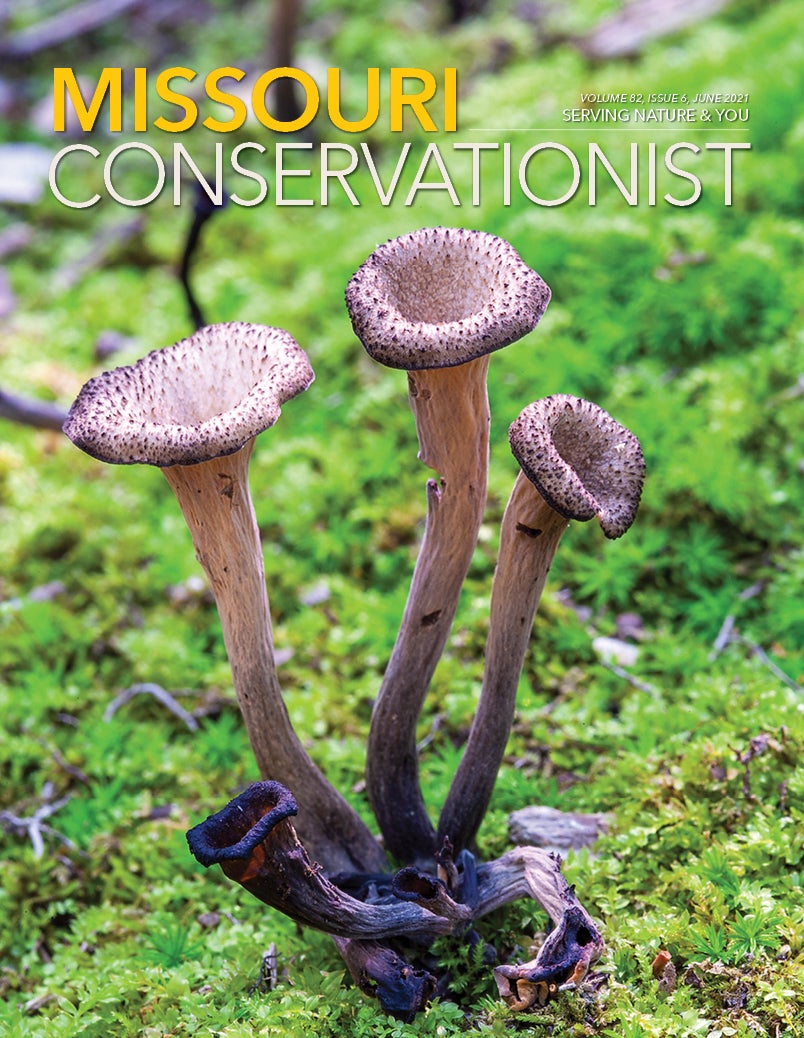
If anglers were to list the qualities of the perfect fish to pursue, undoubtedly the words plentiful, catchable, sizable, hard-fighting, and tasty would be mentioned. We are blessed to have many such fish in Missouri, but one species is often overlooked, Cyprinus carpio.
Carp reside in about every corner of the state, can be pursued with minimal gear and bait, average 8–10 pounds (but can grow to more than 40 pounds), can pull like a freight train, and, when prepared properly, make a delicious meal. Anglers across the nation are catching onto these facts, and the challenge of the “suburban salmon” or “freshwater bonefish” is becoming more popular every day. Missourian’s should be salivating at the chance to pursue this fish, but as soon as many hear “common carp,” the misconceptions about this fish lead them astray: trash fish, bottom feeder, scum sucker, sewer bass, and the list goes on.
‘High-class’ food moves west
The common carp inhabited Europe and Asia long before making its way to the United States. In China and Japan, it was esteemed as a symbol of strength and courage. Japanese samurais would carry banners adorned with carp to symbolize their status. In Europe, they were revered as a high-class food source. Kings and queens were once among the few that were worthy of having a meal of carp. Special holding ponds were created to raise and fatten the delicacy prior to consumption. As it escaped the ponds into the European waterways, the prize fish became more available to the rising population of middle class citizens.
When European immigrants of the mid-1800s came to the New World, their taste for the fish suffered, as common carp were not present. Demand for the fish ensued with thousands of letters a year being sent to the United States Commission of Fish and Fisheries. With populations of native fish plummeting by the millions of pounds from being netted to supply food for the expanding East Coast, the commission had already been looking for a fish to introduce to keep up with the harvest. There are some accounts of common carp being brought into the United States as early as 1830, but the first federal government introduction occurred in 1877, when a few hundred common, mirror, and leather carp were imported and stocked into ponds in Baltimore. Soon, the subsequent 6,000 fingerlings were distributed across 24 states and into Missouri in 1879. By the late 1800s, they were nationwide.
An Abundant Omnivore
Common carp are a warm water species and can be found in a variety of water sources throughout the state. They are most abundant in large rivers and lowland waterways but can also be found in small streams, ponds, and lakes. During their late spring/early summer spawning, they deposit eggs numbering up to 500,000 on submerged vegetation. Within a week, the small fry emerge and begin feeding on plankton. Although often thought of as being mud suckers, adult common carp are actually omnivores. Surprisingly to many, most of their diet comes from aquatic insects, but they also consume a variety of vegetation.
Common carp are one of the largest members of the family Cyprinidae, the minnow and carp family. The Missouri state record common carp, weighing in at 50 pounds, 6 ounces, was caught on a rod and reel in Moberly in 1996. Common carp exist in a few other varieties such as mirror carp, which are only partially scaled along their sides, leather carp, which have very few if any scales, and koi, which are often seen in water gardens or small ornamental ponds.
A Tough Fight
Just about any rod and reel can be used to catch common carp, but it should be one that can handle a tough fight. The thick body and powerful tail of a 10-pound carp can test the drag of your reel and the strength of your rod in a hurry. The combination of a 6-foot medium action spinning or spin-casting rod, a reel that can free-spool, and 10-pound braided line is a good place to start.
Common carp are far more intelligent than they are given credit for, and will often drop a bait as soon as they feel any resistance. The free-spooling reel allows a better opportunity for them to take the bait and additional time to set the hook. Bite alarms were developed to detect bites while free-spooling and can make watching your rods easier by allowing you to listen as well. When a fish picks up the bait, the fishing line runs over a magnetic roller or moves under the watchful eye of a digital sensor and the alarm sounds.
Worms, Corn, and the Breakfast of Champions
Common carp can be caught on a variety of baits including worms, whole kernel sweet corn, and homemade Wheaties balls. If carp fishing with worms, you are likely to attract the attention of every other fish species in the vicinity. The chances of the worm lasting until the carp shows up are not in your favor. Whole kernel sweet corn can also attract a few turtles and panfish but is probably the easiest to use and is readily consumed by any common carp in the area. A Size 4-8 single baitholder hook below a slip sinker can be very effective. Three or four corn kernels threaded onto the hook will usually cover it and still be a small enough bait for the carp to pick up.
Homemade Wheaties balls also work very well and with a little practice are simple to make. The wheat cereal contains enough gluten to form into a “dough” when mixed with water. Although they can be prepared ahead of time, it’s just as easy to do while you are at your fishing location. Hold a handful of the cereal, close your hand around it, and dip it into the water. Squeeze the water and cereal together until the flakes begin to crumble. Continue dipping and squeezing until the dough is formed. Form the dough around a Size 4-8 treble hook that is tied below a slip sinker. When made properly, the dough will stay on the hook easily during casting and will require a quick jerk on the rod to come off the hook. Whatever bait is selected, simply toss it into a likely area and let it sit on the bottom until a bite occurs much in the same way that catfish are pursued.
Weed Beds and Clear Patches
As mentioned, fishing locations containing common carp are available in most areas throughout the state. Like most fish, carp are rarely far from their food sources. Look along weed beds where carp can find snails, beetles, insect larvae and plant seeds. Watch for clear patches that could indicate a carp feeding area. If there is a local pond where residents enjoy feeding ducks or geese, any carp in the water will quickly learn and congregate around this food source.
Common carp can be caught throughout the year, but they are most active during the warmer seasons
when their metabolism is elevated. They can be found in shallow water areas during the summer but also during the winter as the sun will heat these areas more rapidly. An escape route to deeper water is often close by and they will disappear quickly if spooked. Although common carp can be caught at any time of the day or night, they typically feed more aggressively at dawn, dusk, and throughout the night.
Fly Fishing
Since common carp often feed on aquatic insects, it only stands to reason that eventually anglers would realize the potential to use a fly rod to tangle with these beasts. Fly fishing for carp is growing in popularity and is likely the source of the suburban salmon and freshwater bonefish nicknames that the common carp has acquired.
Since common carp can often be seen cruising through shallow areas, sight casting to them with a fly rod can be an adrenaline pumping way to test your skills. A 9-foot, 8-weight rod will get you started. As with all fishing, imitating the food source
is the way to success, and a Clouser swimming nymph will often prove effective for common carp. Place the fly about a foot in front of the carp’s mouth, which will allow them to spot it while limiting the chance of spooking it. If a bite occurs, set the hook quickly as the wary carp will soon realize the fly does not taste like the meal it thought it was.
Proper Prep Provides Fine Fare
The historical European opinion that common carp is a delicious and a welcome addition to the dinner table continues. Carp is prepared in the finest of European restaurants by top notch chefs and fetching five-star prices. The perception here of having carp on the menu is quite different, where many believe it’s not worthy of consumption. Like any fish or wild game, common carp provides fine table fare if handled, processed, and prepared properly.
If you plan on eating a common carp or any fish, keeping it fresh until you return home is vitally important to preventing spoilage. While still fishing, secure the carp on a stringer or in a basket so that it remains alive in the water or place it in a cooler of ice to retain freshness. As soon as possible, process the fish. Begin by removing the scales from the carp and then filet it as you would any other fish but leave the skin on the filet. The rib bones can be very large, so working your knife over them instead of cutting through them is recommended. Common carp have a “mud vein,” or a strip of darker meat, that runs along the lateral line, similar to white bass. If this strip is not removed, it can result in a strong, unpleasant taste. Once the filet is removed from the fish, make a v-cut along each side of the darker meat and remove it from the filet.
Many people believe that carp are inedible due to the amount of bones in the meat. There are two sets of “y-bones.” The top set runs above the lateral line from the tail to the head. The bottom set runs below the lateral line from the tail to the rib cage. If the flesh is scored prior to frying, the hot oil can dissolve them and result in a “boneless” filet. Similar to preparing sucker fish, score the fish by making vertical cuts into the filet. The cuts should be about 1/8 inch apart and be made along the entire length of the filet. Cut down through the meat just to the skin. Do not cut through the skin. Once the filets are prepared, coat them in your favorite breading and deep fry until golden brown. When properly prepared, common carp have a mild flavor that results in a tasty meal.
Like their name implies, common carp are very common throughout Missouri. Although often overlooked by many anglers, they provide a great opportunity to catch an abundant, hard-fighting fish that can make a great addition to your next fish fry.
- Wash filets thoroughly, and then then pat dry.
- Dredge filets in favorite breading mix or use equal parts flour, baking mix, and cornmeal seasoned with salt and pepper.
- Place into deep fryer with oil at 350 degrees.
- Fry until golden brown and filets float to the top of the oil.
- Remove filets and drain on paper towels.


























Also In This Issue

A buffet beyond morels.

Exploring the strange world of copperheads
And More...
This Issue's Staff
Editor - Angie Daly Morfeld
Associate Editor - Larry Archer
Photography Editor - Cliff White
Staff Writer - Bonnie Chasteen
Staff Writer - Kristie Hilgedick
Staff Writer - Joe Jerek
Designer - Shawn Carey
Designer - Marci Porter
Photographer - Noppadol Paothong
Photographer - David Stonner
Circulation - Laura Scheuler






















